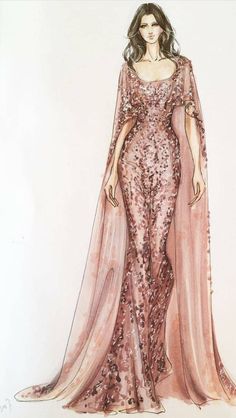Fashion Ilustration Drawing
Fashion illustration drawing is a fundamental skill for fashion designers, serving as a visual language to communicate ideas, concepts, and designs. This class note explores the art of fashion illustration drawing in fashion design, covering its importance, techniques, styles, historical context, contemporary applications, and practical insights for aspiring designers aiming to master this essential aspect of the creative process.
Importance of Fashion Illustration Drawing
Fashion illustration drawing plays a crucial role in the design process and fashion industry:

- Visualization of Ideas: Allows designers to visually express their creative concepts and design visions.
- Communication Tool: Communicates design details, proportions, fabrics, and colors to clients, collaborators, and manufacturers.
- Design Development: Facilitates exploration of various design possibilities and iterations before creating physical garments.
- Portfolio Presentation: Essential for showcasing design skills and artistic talent in portfolios for job applications or fashion school admissions.
Historical Context
Fashion illustration has evolved alongside the fashion industry, reflecting changes in styles, trends, and artistic movements:
- Early Influences: Early fashion illustrations date back to the Renaissance period, where artists depicted clothing styles of the time in detailed drawings.
- Golden Age of Illustration: Flourished during the late 19th and early 20th centuries, with illustrators like Rene Gruau and Antonio Lopez shaping the visual identity of fashion magazines and haute couture.
- Digital Revolution: In the 21st century, digital tools and software have revolutionized fashion illustration, offering new possibilities for creativity and collaboration.
Techniques and Styles
Fashion illustration drawing encompasses various techniques and styles, each contributing to the diversity and richness of the art form:

- Sketching Basics:
- Gesture Drawing: Captures the essence of movement and posture in quick, fluid lines.
- Proportions and Anatomy: Understanding human anatomy and proportions is essential for realistic and expressive figure drawing.
- Rendering Techniques:
- Line Work: Use of varied line weights to create depth, texture, and emphasis in drawings.
- Shading and Rendering: Techniques like hatching, cross-hatching, and stippling to add dimension and volume to garments.
- Color Application:
- Watercolor: Delicate and translucent colors used for soft and expressive illustrations.
- Digital Coloring: Allows for precise color control and experimentation with textures and effects.
- Style Diversity:
- Realistic Illustration: Detailed and lifelike representations of fashion designs and figures.
- Abstract and Avant-Garde: Expressive and experimental styles that push the boundaries of traditional fashion illustration.
- Minimalist and Line Art: Simplified forms and clean lines that focus on essential design elements.
Contemporary Applications
Fashion illustration drawing continues to play a vital role in the modern fashion landscape:
- Runway and Collections:
- Fashion Shows: Illustrations used to preview and visualize upcoming collections before they are produced.
- Lookbooks and Campaigns: Illustrations featured in lookbooks, advertising campaigns, and promotional materials to convey brand identity and aesthetic.
- Digital Platforms:
- Social Media: Instagram, Pinterest, and other platforms used by fashion illustrators to showcase their work and connect with a global audience.
- Online Publications: Fashion blogs, websites, and digital magazines feature fashion illustrations as editorial content and trend forecasts.
- Collaborations and Licensing:
- Collaborative Projects: Fashion illustrators collaborate with brands, designers, and influencers for capsule collections and special projects.
- Licensing: Illustrations licensed for merchandise, stationery, and other fashion-related products.
Practical Insights for Aspiring Designers
Mastering fashion illustration drawing requires dedication, practice, and attention to detail:

- Study of Fashion Figures:
- Anatomy: Study human anatomy, proportions, and poses to accurately depict figures in various poses and movements.
- Fashion Silhouettes: Understand garment construction, draping, and how fabrics fall on the body.
- Experimentation and Exploration:
- Sketchbooks: Maintain a sketchbook for daily practice and experimentation with different styles, techniques, and media.
- Inspiration: Draw inspiration from fashion history, art movements, cultural influences, and personal experiences.
- Digital Tools and Software:
- Digital Illustration: Familiarize yourself with software such as Adobe Illustrator, Photoshop, and Procreate for digital rendering and coloring.
- Tablet and Stylus: Use of digital tablets and styluses for precise control and ease of digital drawing.
- Portfolio Development:
- Quality vs. Quantity: Focus on creating a portfolio that showcases your best work and demonstrates your range of skills.
- Presentation: Present your work professionally, with clear labeling and organization to highlight your strengths and versatility.
Conclusion
Fashion illustration drawing is both an art form and a practical skill that empowers fashion designers to visualize, communicate, and innovate within the industry. By mastering techniques, exploring styles, and embracing digital tools, aspiring designers can leverage fashion illustration as a powerful tool for creativity, expression, and professional advancement. As fashion continues to evolve, the role of fashion illustration remains integral, bridging the gap between conceptual ideas and tangible designs, and shaping the visual narratives that define contemporary fashion aesthetics.
